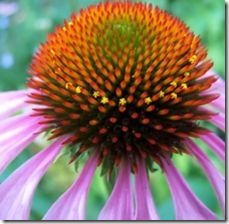The cone flower is a plant, native to North America, with purple petals around a brown center. Petals lie almost vertically and they come off of the center, creating a cone-like shape. It is increasingly affected by a condition called coneflower disease, or aster yellows, which causes severe bloom disfigurement. Understanding the causes, symptoms and appropriate treatment for this plant disease can help identity infection and limit disease spread.
Symptoms
-
Plants infected with aster yellows suffer a variety of symptoms, which affect multiple areas of development. The leaves of an infected plant have veins that lose color, and new leaves are often yellow. In the coneflower specifically, the most serious symptom is the mutation of the plants’ blooms. The flowers are replaced by green tufts, which look like modified leaves, or tufts of grass. These tufts appear to grow out of the center of what would otherwise be the bloom, and petals are nonexistent, or wilted and discolored.
Cause
-
Coneflower disease is the result of a plant’s infection with a microorganism scientifically referred to as a phytoplasma. The phytoplasma is smaller than bacteria, but larger than a virus, and infects plants in much the same manner as these two disease causing agents. The phytoplasma can survive between growing seasons in ornamental perennials and in weeds.
Transmission
-
The microorganisms, phytoplasma, which cause aster yellows are predominantly spread by leafhoppers. The phytoplasma lives in a plant’s phloem. When leafhoppers feed off of the phloem of infected plants, the phytoplasma moves into the leafhopper’s stylet. The leafhopper then carries the phytoplasma in their stylet to the next plant. When they insert their stylet into a healthy plant, it delivers the disease directly into the plant’s phloem, causing infection.
Diagnosis
-
Diagnosis is largely made through observation of symptoms. It can be hard to get a definitive diagnosis of coneflower disease because the phytoplasma which causes the condition cannot live outside of live plant tissue. This means that it cannot be isolated and cultured in a laboratory, for either identification or research purposes. An electron microscope can be used in the field to examine phloem for infection.
Treatment
-
There is no effective treatment for aster yellows. Antibiotics have been used to treat plants with some success, but it is not cost-effective in common flowers. Infected plants should be removed and destroyed as quickly as possible to reduce the disease’s spread. Chemical control of leafhopper populations and perennial weeds can also reduce the number of phytoplasma infections.


Deprecated: strpos(): Passing null to parameter #1 ($haystack) of type string is deprecated in /home/agriviek8Qv/agriviet.net/public_html/wp-includes/comment-template.php on line 2522